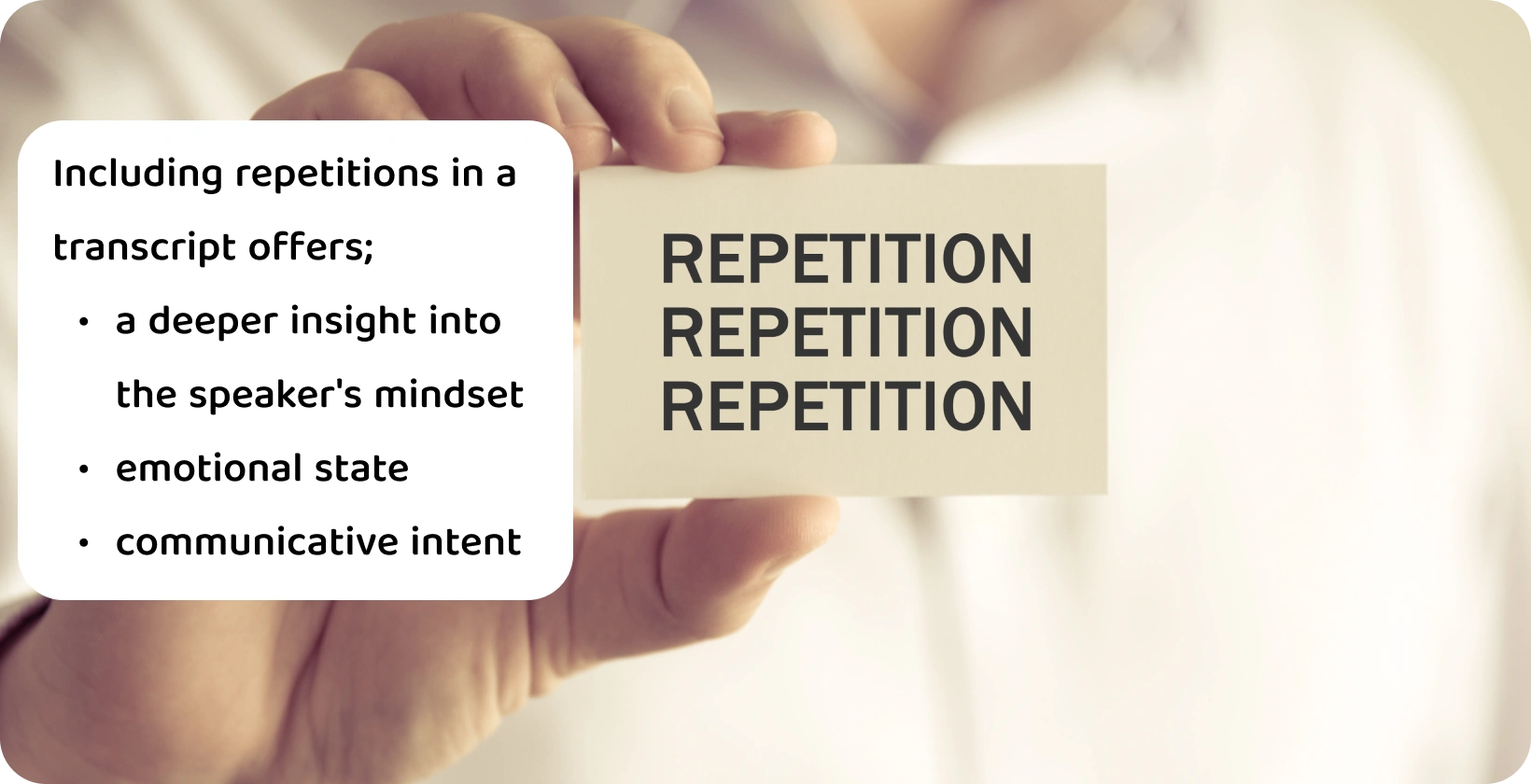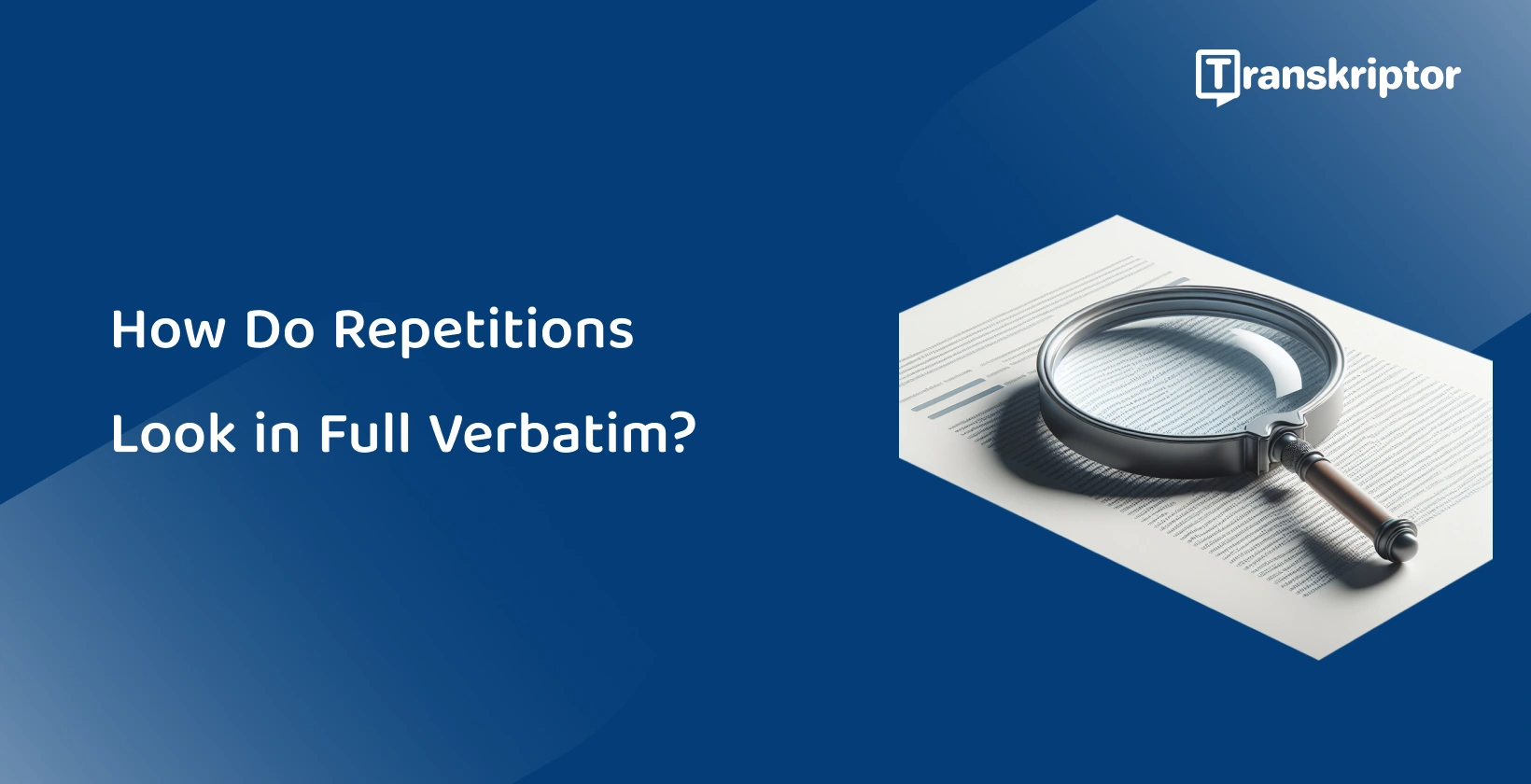Defining Full Verbatim Transcription
Full verbatim transcription refers to the capture of every sound heard in an audio recording, including words, non-verbal communication (like laughter or sighs), and, notably, repetitions. This method is a mirror reflection of the spoken word, providing a text that’s as close as possible to the original audio. It’s favored in situations where the manner in which something is said is as important as the words themselves, such as in legal proceedings, psychological evaluations, or qualitative research.
What are Repetitions in Full Verbatim?
In full verbatim, repetitions refer to words or phrases that are spoken multiple times in succession or throughout the audio. For example, a speaker might say, "I was, I was just thinking," or "You know, you know, you know?" These repetitions are transcribed exactly as they occur, with no omissions or alterations. This approach ensures that the transcript fully captures the speaker's speech patterns and hesitations, providing a complete and accurate representation of the spoken word.

Why is it Important to Note Repetitions in Transcription?
Repetitions can significantly affect the reader's understanding and interpretation of a transcript; they can indicate the speaker's uncertainty, emphasize a point, or simply be a habit of speech, which is why including these repetitions in a transcript offers a deeper insight into the speaker's mindset, emotional state, and communicative intent. For researchers or legal professionals, this level of detail can be invaluable for analysis or evidence.
Techniques and Practices for Handling Repetitions
Recognizing the Importance of Repetitions
In full verbatim transcription, repetitions are not merely textual redundancies; rather, they serve as a mirror to the speaker's thought processes, emotional states, or emphasis on certain points. They offer insights into the speaker's intent and can significantly impact the transcript's interpretive value, and leaving these out can drastically impact someone’s understanding of the speech.
Accurate Documentation of Repetitions
So, the burning question: what’s the best way to note these when transcribing? Essentially, the key to handling repetitions lies in meticulous listening and precise transcription; every repeated word or phrase, no matter how seemingly insignificant, must be documented exactly as spoken. This accuracy ensures the transcript faithfully represents the speaker's original speech pattern and intent, preserving the authenticity of the dialogue.
Consistency in Transcription Practices
Finally, consistency is crucial when transcribing repetitions, so establishing a standard practice for documenting repeated words or phrases will help you to maintain the clarity and readability of any transcript. Whether a speaker repeats a word for emphasis or out of habit, each instance should be transcribed to reflect the speaker's true voice, and ultimately ensuring a faithful record of the spoken word.
How Should Transcriptionists Handle Excessive Repetitions?
When it comes to full verbatim transcription, even excessive repetitions should be documented exactly as they occur; this approach ensures the transcript remains a faithful account of the audio, preserving all nuances of the speech.
When Should I Not Include Repetitions?
Typically, the general rule is to include every spoken element to capture the essence and nuances of the original audio accurately. However, there are instances where omitting repetitions might be considered, depending on the purpose of the transcription and the preferences of the end user.
For most academic, legal, and professional settings where full verbatim is requested, including repetitions is essential for maintaining the integrity and authenticity of the transcript. These repetitions can reveal much about the speaker's intentions, emphasis, and emotional state, so they shouldn’t be excluded.
Yet, in scenarios where the readability of the transcript is prioritized over strict adherence to the spoken word - for example, in video to text transcription - some discretion may be used. Here, you might decide to omit or minimize repetitions that do not add significant value to the understanding of the text, especially if they overly clutter the transcript without providing additional insight.
The Bottom Line
Ultimately, when it comes to creating an accurate and loyal transcription of speech - aka full verbatim transcription - repetitions shouldn’t be excluded or omitted; in most cases, these repetitions offer a window into the speaker's mind, adding depth and authenticity to the text. Remember, in the realm of transcription, accuracy is everything, and the true art of the craft lies in capturing not just the words, but the very essence of the spoken communication.


